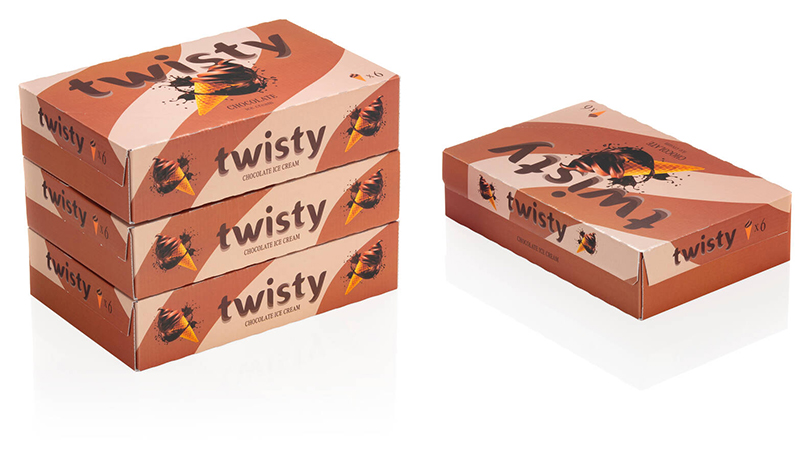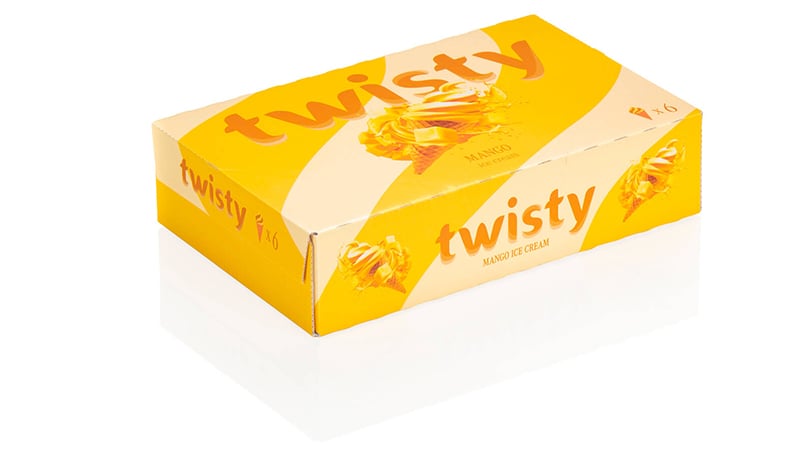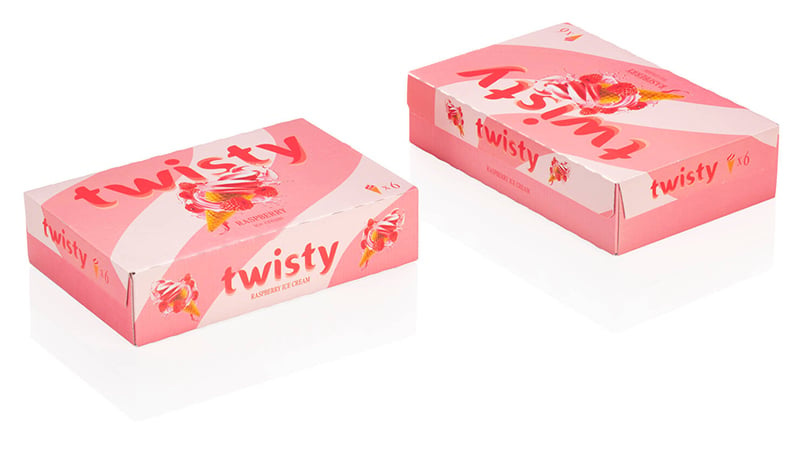November 27, 2023
(press release)
–
Metsä Board collaborated with industry leaders to re-design a favourite of the frozen food aisle: packaging for ice cream cones. The team looked into different stages of the value chain, ranging from material production, to ink usage and logistics. The result is a packaging with a significantly lower climate impact. The team, consisting of design printing and converting experts first analysed frozen food packaging currently on the market to identity areas of improvement. These solutions traditionally rely on recycled fibres and spot colour printing. With this project the team wanted to showcase new possibilities using carefully selected lightweight fresh fibre materials and flexographic printing methods to achieve excellent usability and unparalleled halftone graphics with less impact on the climate. Metsä Board’s double coated white-top kraftliner (MetsäBoard Prime WKL, 125 g/m2) was selected as the top liner as it is light in weight and has a smooth surface that enables excellent reproduction of detailed visuals. The inside liner and fluting were made from uncoated kraftliner (MetsäBoard Natural WKL Bright 90 g/m2) which is ideal for small and lightweight packaging requiring high strength. Both materials are made from pure and traceable fresh wood fibre making the packaging easily recyclable or compostable and safe for food packaging. Having two layers from same material also simplified production without compromising quality. Metsä Board’s Sustainability Services did detailed calculations of the paperboard materials comparing them to traditional white lined chipboards used in the European market. Due to the 8 per cent lighter weight and use of fossil free energy that is generated as a by-product of Metsä’s chemical pulp production the new packaging was found to have up to 36 per cent lower climate impact (Cradle-to-Gate + End-of-Life).* Packaging designers at Futupack paid special attention to the user experience by creating an easy-to-open design, eliminating the need for plastic parts or special tools for opening. Special attention was also paid on minimising the usage of ink, while still keeping the different taste variants recognisable. Process printing was selected as the printing method, to eliminate the use of spot colours and the enhance efficiency and flexibility. Packaging manufacturer Adara Pakkaus, proposed 64 lpcm expanded colour gamut (ECG) co-printing as a suitable method for the corrugated board. The flexo printing plates were supplied by Marvaco. By using the carefully selected kraftliner materials, the team was able to eliminate the ‘wash board effect’ common in corrugated boards. ”This high-resolution quality is unusual in such solutions; corrugated post print typically achieves lower accuracy. ECG benefits co-printing, consolidating designs, reducing waste, plates, energy, and press return inks,” tells ECG printing specialist Dr Kai Lankinen, who consulted in the project. Adara’s Head of Printing Lari Seppälä is especially proud of the eco-efficiency of the project which included reviewing the entire process for selecting options to lower the environmental impacts. “With our new 7-colour press and ECG tools we were able to reduce ink usage, simplify logistics and make the entire process flexible as well as cost-efficient. We used a 4-colour set, with upgraded water-based inks adopting Siegwerk's UniNATURECor Postprint Process Extender (15-001155-9), having an 49 per cent Bio Renewable Content (BRC) and 26 per cent lower carbon footprint.” Earlier this year the same expert team worked on another project designing the ultralight pizza box. “This ice cream packaging project showcased again the power of seamless teamwork. With the careful selection of materials, and pushing the traditional boundaries of printing we were able to combine excellent functionality and resource efficiency. Collaboration was crucial for understanding the requirements and capabilities in the different stages of the supply chain.” concludes Metsä Board’s Packaging Services Director Ilkka Harju. * Metsä Board follows process category rules for processed paper and paperboard which is are based on ISO 14040/14044 life cycle assessment standards when assessing environmental impacts of its paperboards. For comparative assertion external dataset from ecoinvent has been utilized. This dataset represent a typical recycled fibre linerboard on the EU markets. Comparison excludes paperboard delivery as well as printing and converting processes. End-of-life scenario is based on Finnish waste management statistics and assumed to be the same for both packaging solutions. Climate Change methodology used in the assessment was EF3.1 Climate Change – Total
Less materials, less ink

Future-ready printing methods

* All content is copyrighted by Industry Intelligence, or the original respective author or source. You may not recirculate, redistrubte or publish the analysis and presentation included in the service without Industry Intelligence's prior written consent. Please review our terms of use.




